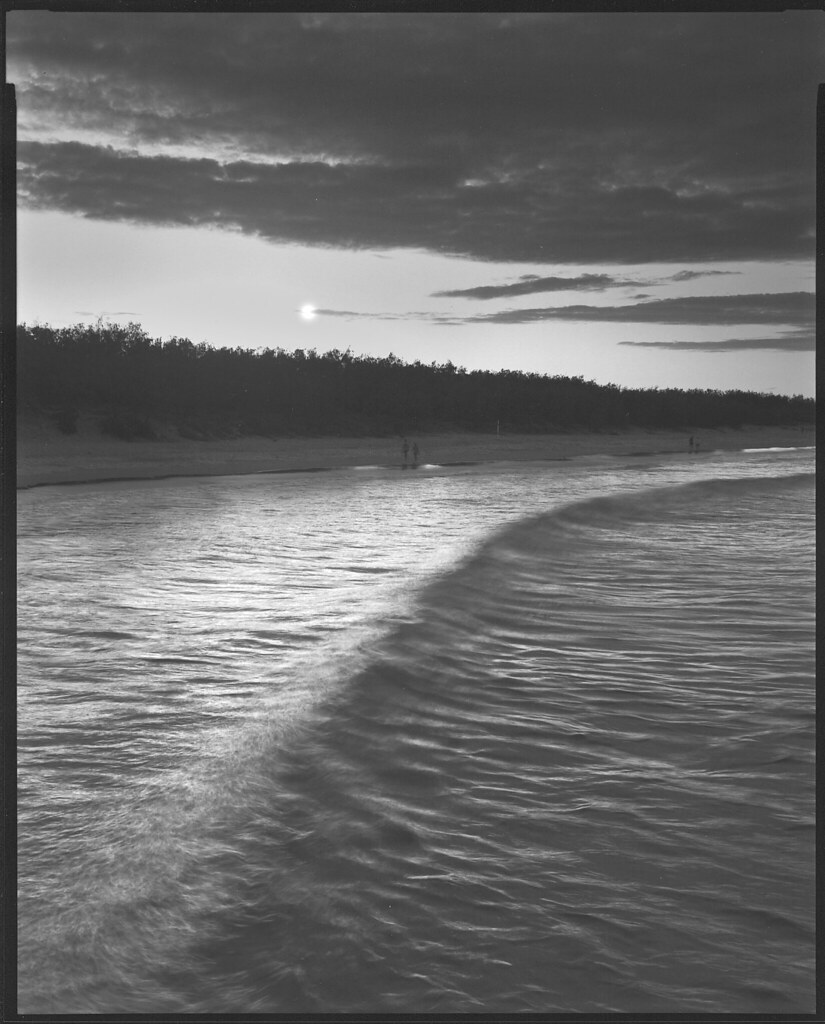A recent
extreme HDR photograph done by me on film:
Gelatin-silver photograph on Kodak Polymax Fine Art VC FB, image area 24.7cm x 19.6cm, from a
Tri-X Pan Professional negative exposed in a Tachihara 810HD triple extension 8x10 field view camera with a Fujinon-W 300mm f5.6 lens and using a #25 red filter and a 1 stop soft ND grad filter.
A modern technique in electronic picture-making is High Dynamic Range processing where several exposures are combined to bridge wide luminance ranges in subject matter. A difficulty with HDR is subject movement but this can also represent an opportunity.
Wave Break, Noosa Beach is high dynamic range subject done on film. The brightness difference between the sun-disk and the shadow side of the line of trees is in excess of
15 stops but the original photograph includes detail in both. Here's how it was done:
The tripod mounted Tachihara 8x10 camera was placed on a low rock wall so it could look toward the beach with a plain sea foreground. Focussing was augmented with a back tilt of the rear standard to place the Scheimpflug plane (the plane of focus) along the water surface and through the distant line of trees. The picture would then be in focus from front to back at any aperture, any shutter speed.
Careful note was made of the upper right-hand corner of the ground glass (bottom left-hand corner of the picture) to establish what part of the sea surface lived there. That patch of sea was committed to secure memory because it would be needed later.
A 6 inch clear plastic ruler was placed on the ground glass of the camera to measure the movement of the wave images. The fastest wave image moved 2 inches in one second. Since I wanted a maximum 1/2 inch blur to imply wave movement but retain wave shape I knew my main shutter speed would be 1/4 second.
The lens was fitted with a Cokin P filter holder carrying a grad ND filter and a #25 red filter. The grad filter was aligned with the tops of the trees. The
first exposure was made at 1/90sec @ f64 with the result that only the sun disk, some bright threads of cloud, some water sparkle and, faintly, the tree line registered on film. The camera was then left completely undisturbed for nearly half an hour while the sun set and the scene darkened.
Before the
second exposure the red filter was removed (carefully!) and the shutter re-cocked at 1/4 second. A spot-meter reading confirmed that an aperture of f16 should be set for the assorted dark tones to fall on Zones II, III, and IV. The last element was getting the wave in the right place. Because the ground-glass was blocked by the film-holder that pre-memorised patch of sea was the aim point for the breaking wave. A few seconds later the shutter was clicked to catch a nice wave as it swept by. The rest was routine.





![[No title]](/data/xfmg/thumbnail/32/32631-60d0db057ee085953a0921e337396654.jpg?1734162116)

![[No title]](/data/xfmg/thumbnail/42/42463-03457f0869c7510e6fb947b21de31aba.jpg?1734176998)





![[No title]](/data/xfmg/thumbnail/41/41894-692c98920dde335de241400937ed6166.jpg?1734176247)
